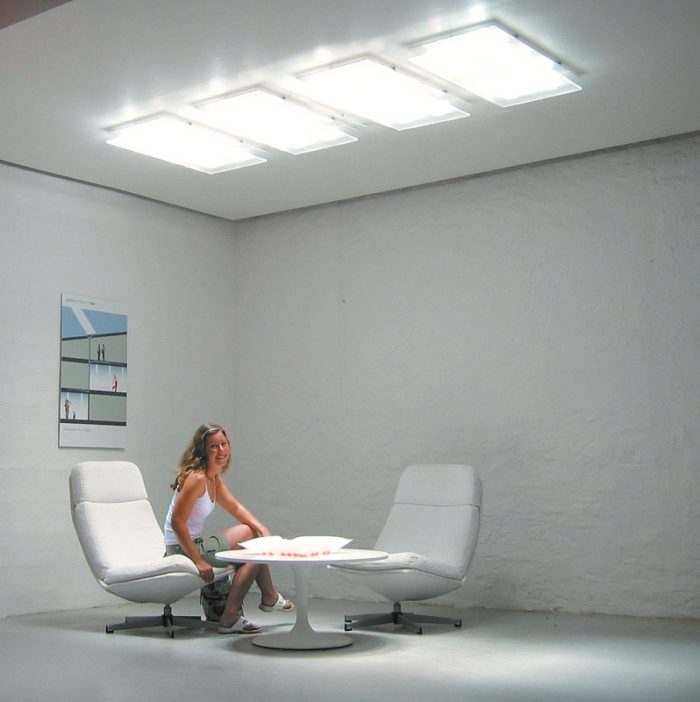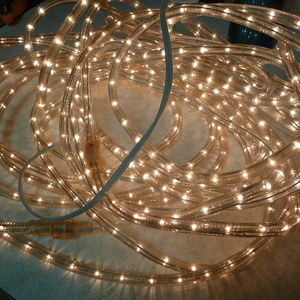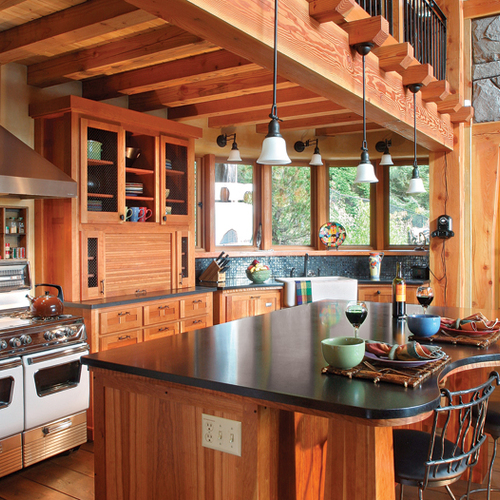Image Credit: Parans Solar Lighting
Image Credit: Parans Solar Lighting The Parans SP2 collector mounts on a roof or wall and has 62 Fresnel lenses that track the sun and focus light into fiber-optic cables
Image Credit: Parans Solar Lighting Each quarter-inch-diameter Parans cable contains 16 optical fibers and can bend to a 2-inch radius.
Image Credit: Parans Solar Lighting This L3 spotlight is one of a number of Parans light fixtures used to deliver light from the optical cable to the living space.
Image Credit: Parans Solar Lighting
Fiber optics, that miracle of modern communications, can also be used to deliver natural light to spaces deep in a building.
Last week I focused on tubular skylights, which provide a great way to bring daylighting into home offices, hallways, bathrooms, and other spaces. An aluminum tube that’s highly reflective on the interior transmits daylight down through an unheated attic to the space below—delivering the light through what appears to be a fairly standard light-diffusing ceiling fixture.
It’s a great technology—especially with the relative low cost—but it has some limitations. You need a relatively straight shot, and it’s hard to extend the tubes through living space to reach first-floor spaces in multi-storey buildings.
For those with deep pockets, “active daylighting” using fiber optics provides a way to bring daylight deep into a home or commercial building—beyond the reach of tubular skylights. I know of two companies that are offering this technology: the Swedish company Parans Solar Lighting, AB (through its U.S. distributor HUVCO Daylighting Solutions), and the Himawari Solar Lighting System from La Foret Engineering Company, Ltd. in Tokyo, Japan.
Here’s how the Parans system works: On the roof or an outside wall, there’s a one-meter-square collector (the SP2) with 62 separate Fresnel lenses that track the sun as it moves across the sky. The SP2 uses about 2 watts of electricity to operate this tracking, which is controlled by a photosensor and microprocessor.
Each of the lenses concentrates the sunlight into a tiny optical fiber, just 3/100ths of an inch (0.75 mm) in diameter. Bundles of 16 of these optical fibers are aggregated into cables (four from each SP2) that are about a quarter-inch (6 mm) in diameter. These cables can be run up to about 65 feet (20 m) to bring natural light to interior spaces quite distant from the roof or windows. The cables can be run through interior wall cavities, ceiling plenums, or wiring chases, and their bending radius can be as tight as two inches! The greater the length, the greater the light loss: at 33 feet (10 m) 64% of the light is delivered; at 65 feet (20 m), only 40%.
In the spaces where light is to be delivered, various fixtures are available. These include spotlights, fairly conventional-looking ceiling fixtures, and some hybrid fixtures that include both daylighting and high-efficiency fluorescent lighting. Some fixtures are served by just one optical cable; others by two or four.
The Parans system is far from inexpensive, with a system starting at about $10,000 for one SP2, four optical-fiber cables, and four fixtures, plus installation. To date, about 20 of these systems have been installed in the U.S., according to HUVCO.
Now, if you think that’s expensive, there’s another system available, at least in Japan. The Himawari Solar Lighting System (named after the Japanese word for sunflower) is a similar, but larger, fiber-optic system that uses tracking Fresnel lenses to capture sunlight and distribute it through a building. The product was first demonstrated in the late-1970s, and over 1,000 of these systems have been installed in Japan and Western Europe since then. Larger installations can cost over $100,000.
Distributed daylighting through optical fibers is an exciting high-tech approach to making use of natural light. If prices come down, this could become a much more practical strategy in the future.
One interesting issue with distributed daylight, according to an expert I spoke with, is that the color of the light changes throughout the day. In the early morning and late afternoon, it can be distinctly orange, while in the middle of the day, it can be quite blue, which gives the light a cool feeling. Some will find this annoying, while others may appreciate the experience of light quality changing during the day—as occurs outdoors.
For more information on Parans Solar Lighting, contact HUVCO at 800-832-6116. I was unable to determine whether the Himawari is available in North America, but will provide that information in a comment if I hear back from the company.
I invite you to share comments on this blog.
Alex Wilson is the executive editor of Environmental Building News and founder of BuildingGreen, LLC. To keep up with his latest articles and musings, you can sign up for his Twitter feeds.
Weekly Newsletter
Get building science and energy efficiency advice, plus special offers, in your inbox.















4 Comments
Himawari
Alex: I have been trying to contact the Himawari people for years, but have had no response on their email. At one point, I found a listing for a US distributor, but was never able to make contact either. Do you know of any US point of sale? Also, the Parans system folks had told me they expected to qualify for the 30% fed rebate for renewable energy sources. Do you know if any of the installation in the US were able to submit for this? Thanks. This is a technology which has great potential, especially for use as urban high-rise green houses, as they are used in Japan.
Contacting Himawari
I'm afraid I've had the same experience with the Himawari. I wasn't even able to get a photo from the manufacturer, and it's not clear who--if anyone--is distributing the product in the U.S. If you do find anything out, please let me know!
As for the 30% tax credit, as you may have seen, I've been fairly critical of the 30-30 rule (the solar heat gain coefficient part of it, which establishes a maximum SHGC of 0.30). See this blog on the windows tax credit: https://www.greenbuildingadvisor.com/blogs/dept/energy-solutions/tax-credits-window-replacement, and also this one on tubular skylights: https://www.greenbuildingadvisor.com/blogs/dept/energy-solutions/tubular-skylights-introduce-daylight-dark-homes, in which I address the issue a bit. SolarTube offers two products that meet the 30% tax credit requirements, but I suspect there's a significant loss of visible light in a product with that low a SHGC. With an active daylight harvesting system, you're paying so much per lumen of daylight that I don't think it makes sense to limit those lumens to satisfy the 30% tax credit requirements. I'd be surprised if Parans were to configure the system to comply.
Himawari
Parans solar lighting writes in one of there quarterly reports that there product now is better than a Japanese competitor. I'm assuming that is Himawari.
Anyway there new product SP3 started production in december 2011. Costs about 4500 dollars.
That is then 6 lights and one solar panel and som fiber optics in that price.
Innovation in solar lighting system
You should also check out the website of ECHY that has developed a new solar lighting system technology. They seem to be able to transport light on over 60m. Their solutions may be a bit less expensive as they are able to capture a greater amount of light.
They have also developed a hybrid system that automatically switches to LED when the sun does not shine.
However I assume that their solution is still mostly dedicated to buildings that live at daytime, ie. offices, hospitals,museums, universities, schools...and not to residential (due to the upfront cost).
As Parans or Himawari, ECHY light preserves all the spectrum of sunlight with all its benefits (moral, well-being, improved concentration for students and employees, accelerated healing for patients) and without its drawbacks (no heat).
Solar lighting systems even quite expensive can bring real value to a building that has many spaces with no access to windows or are dark. With access to natural light windowless square meters can be used for all purposes (work space, classrooms, patients rooms...) and not only as storage spaces.
Log in or create an account to post a comment.
Sign up Log in